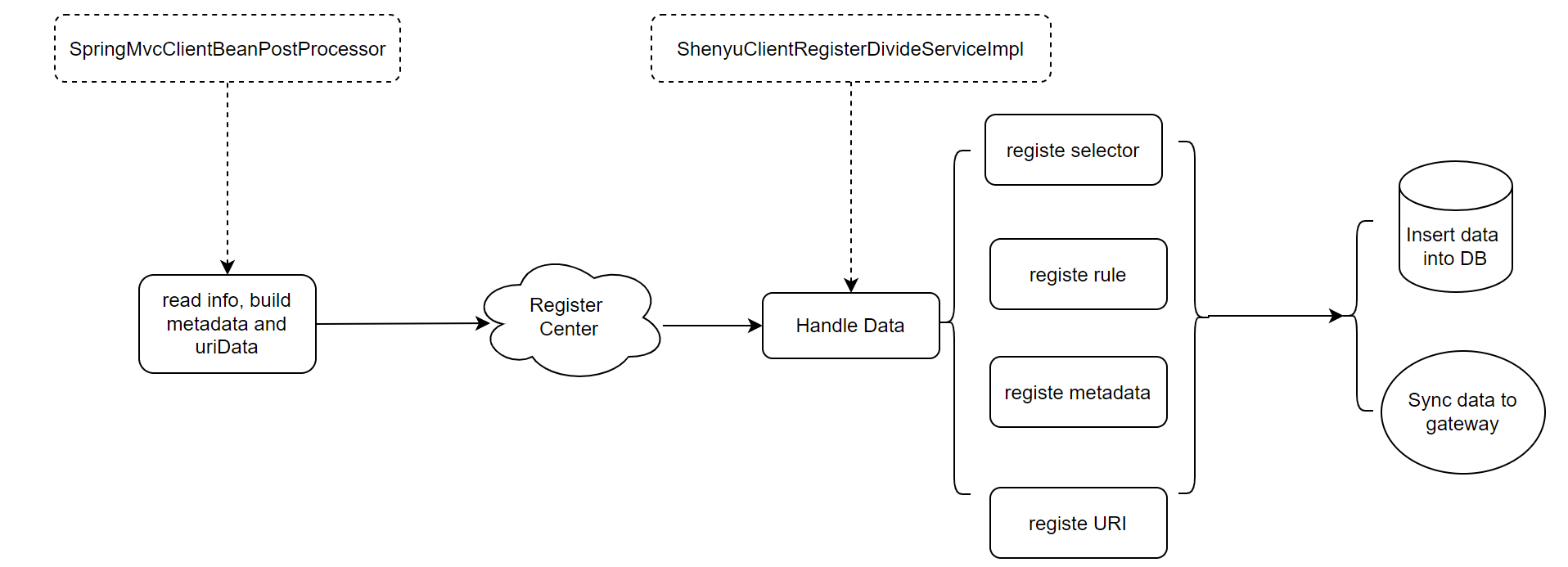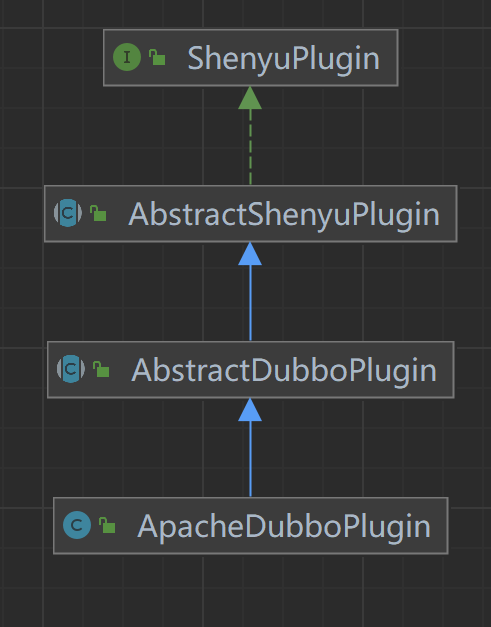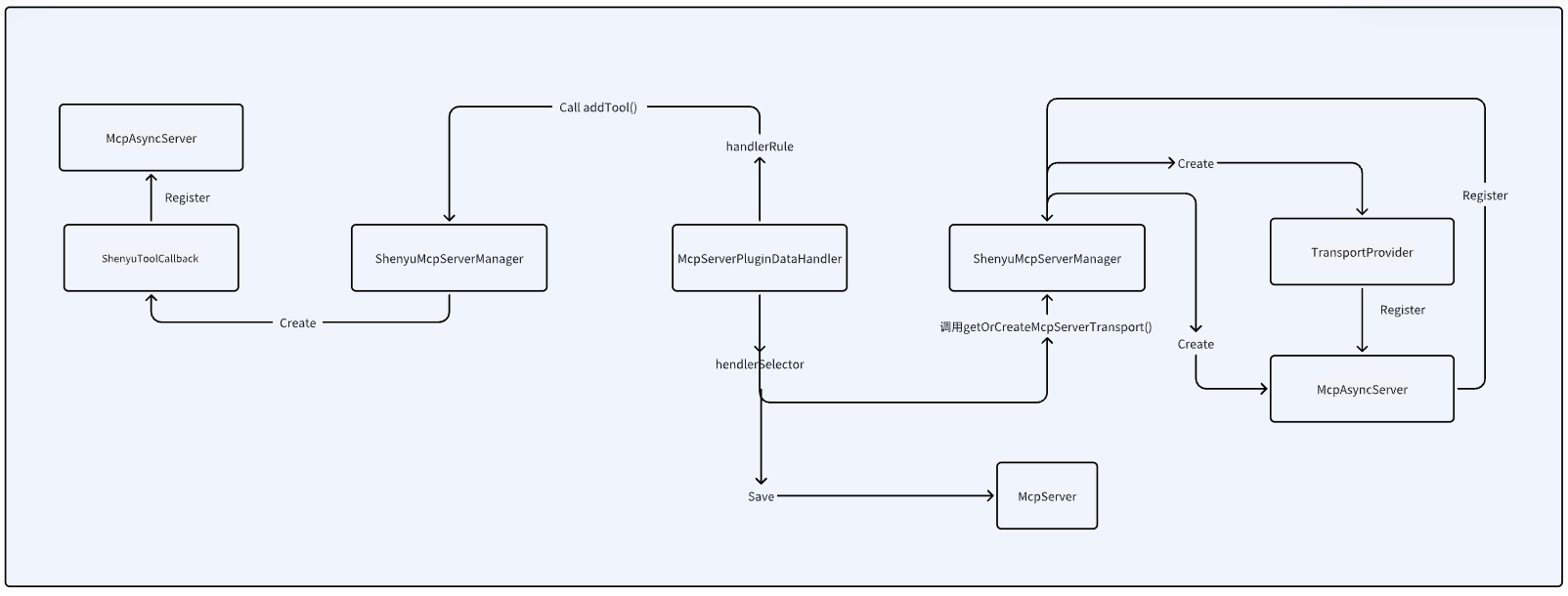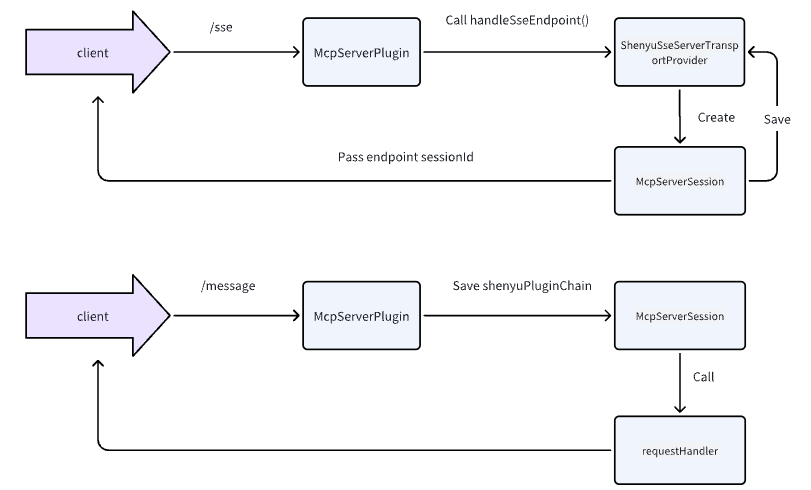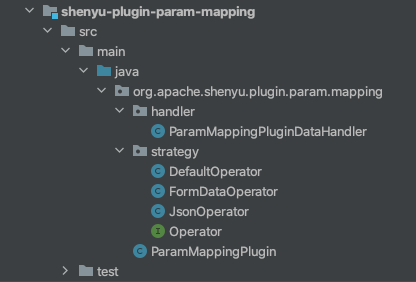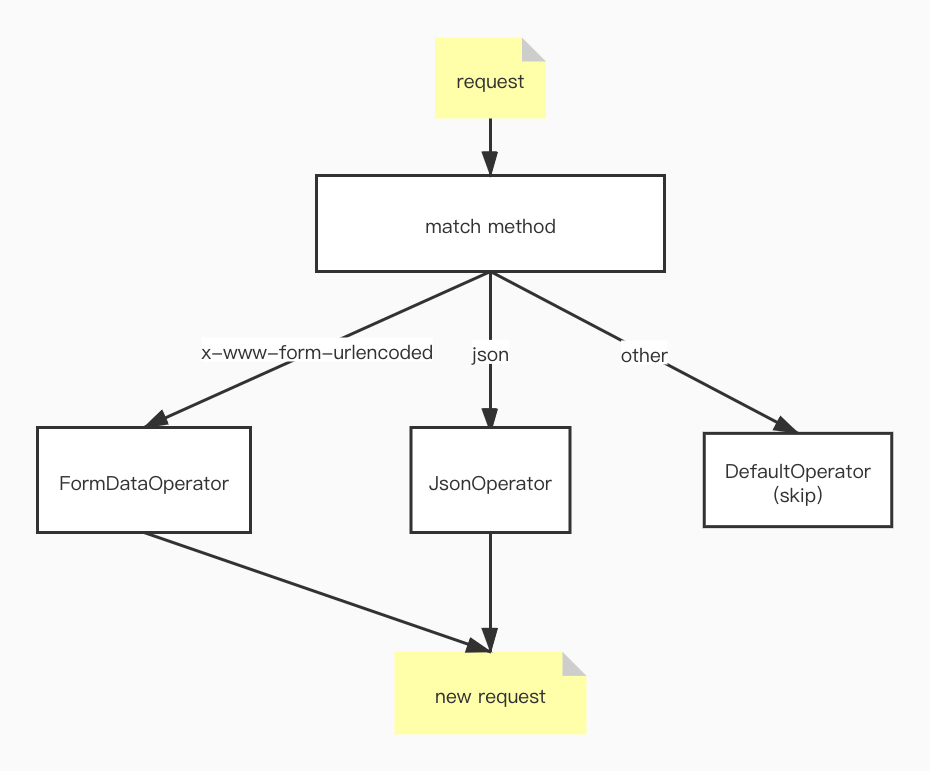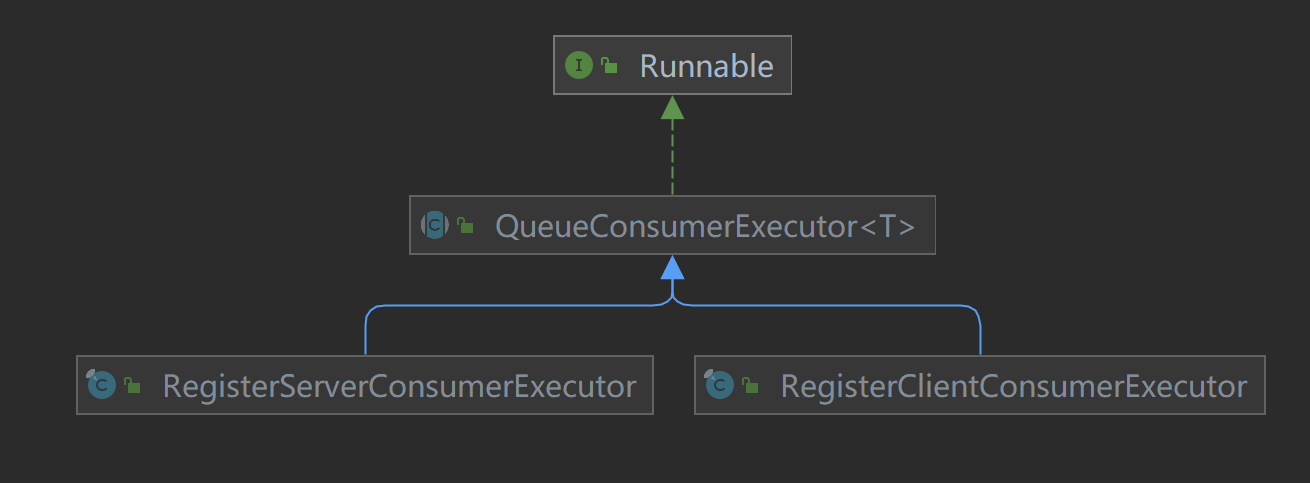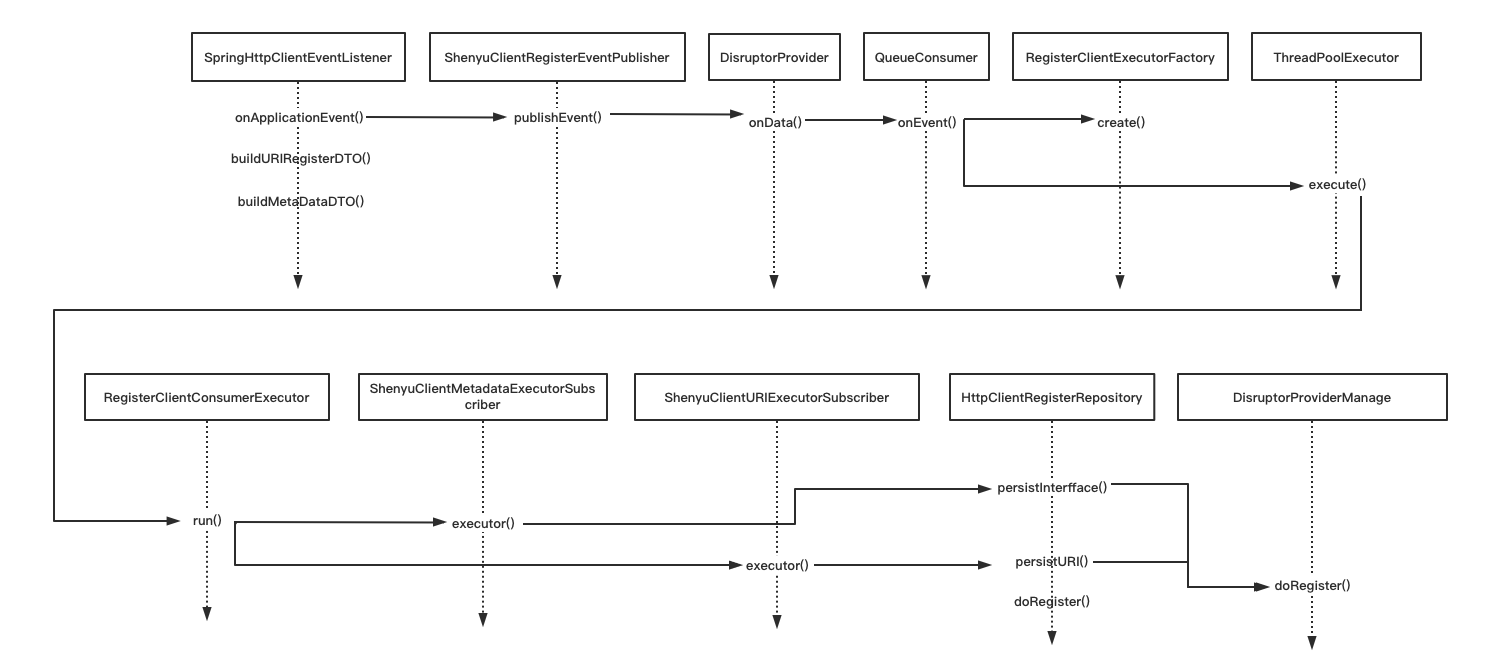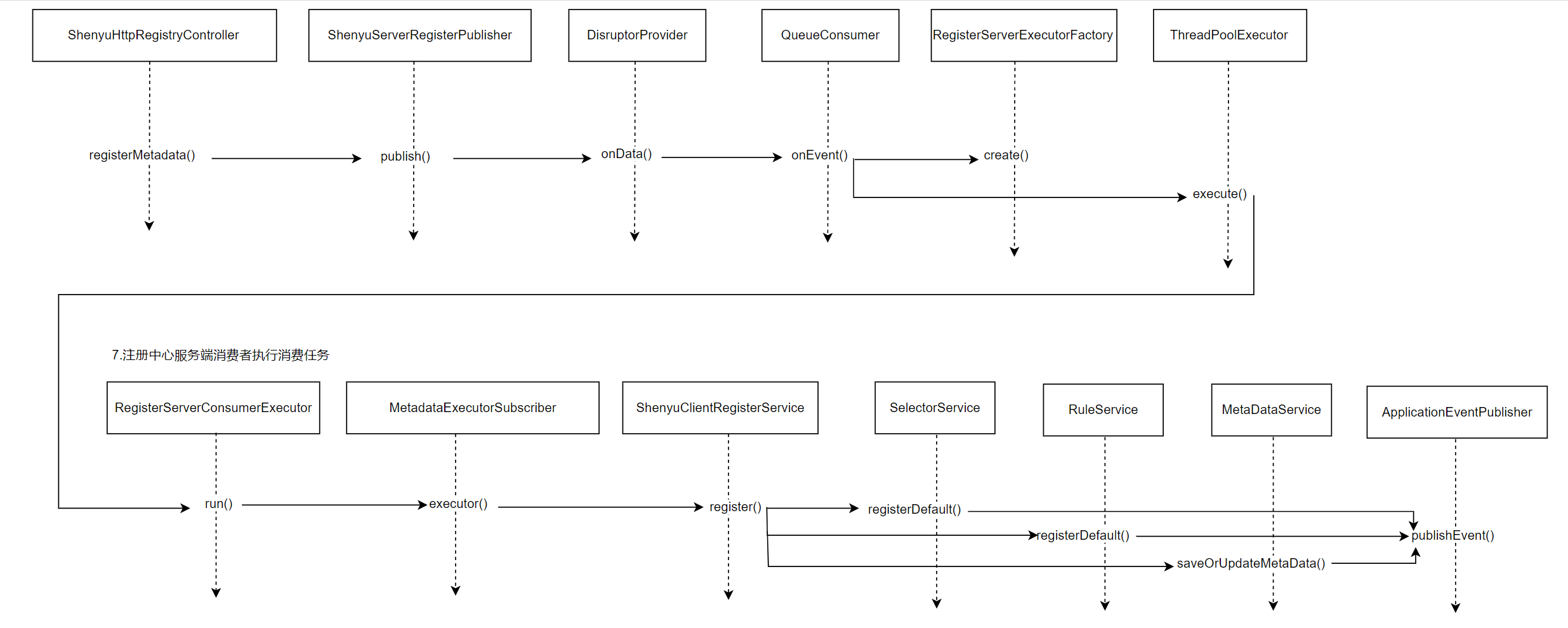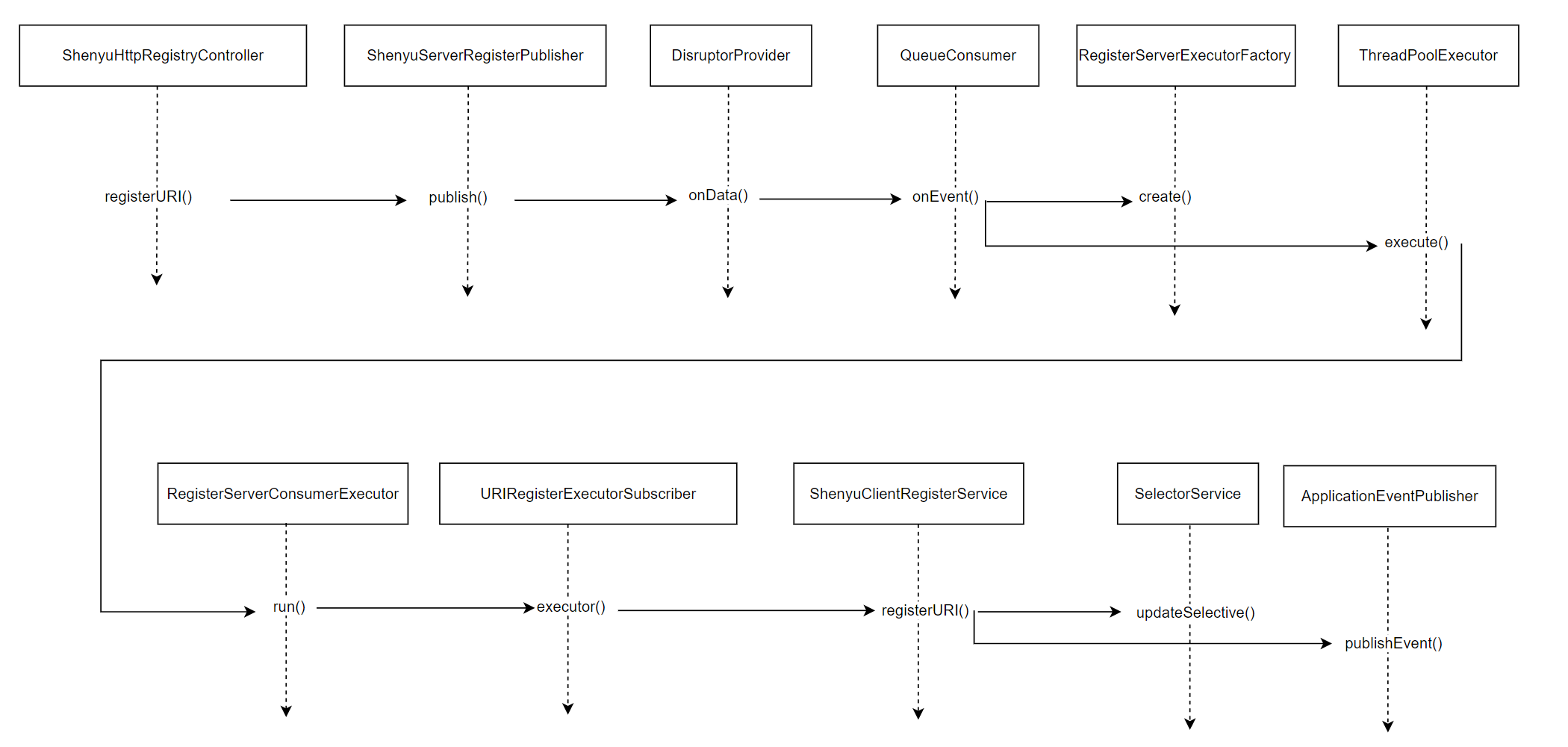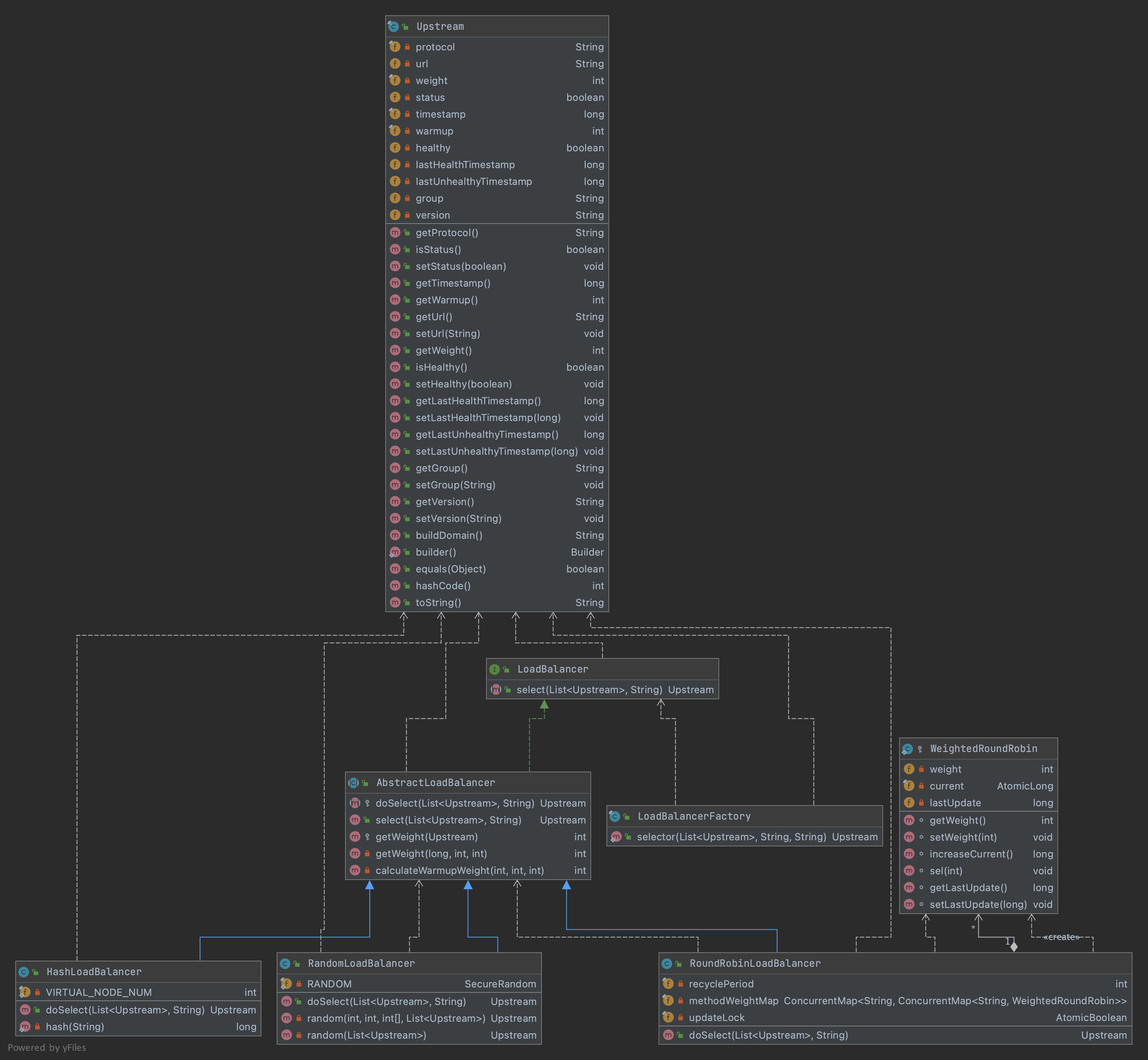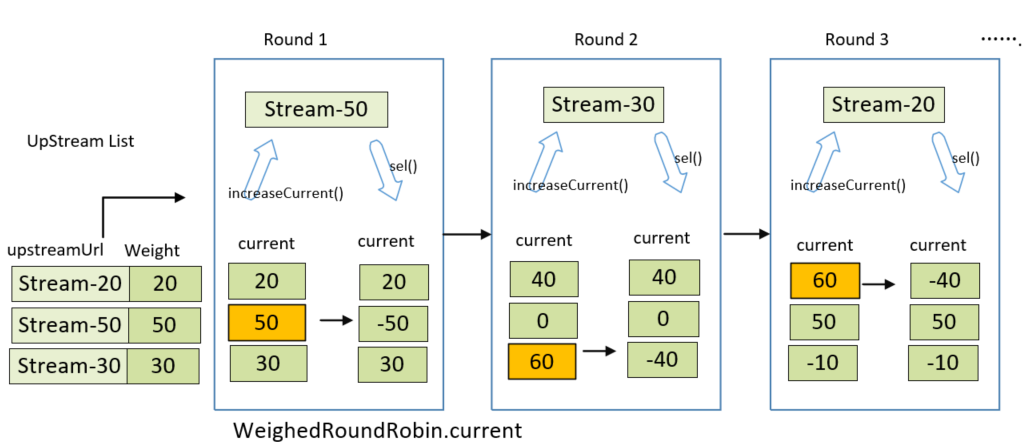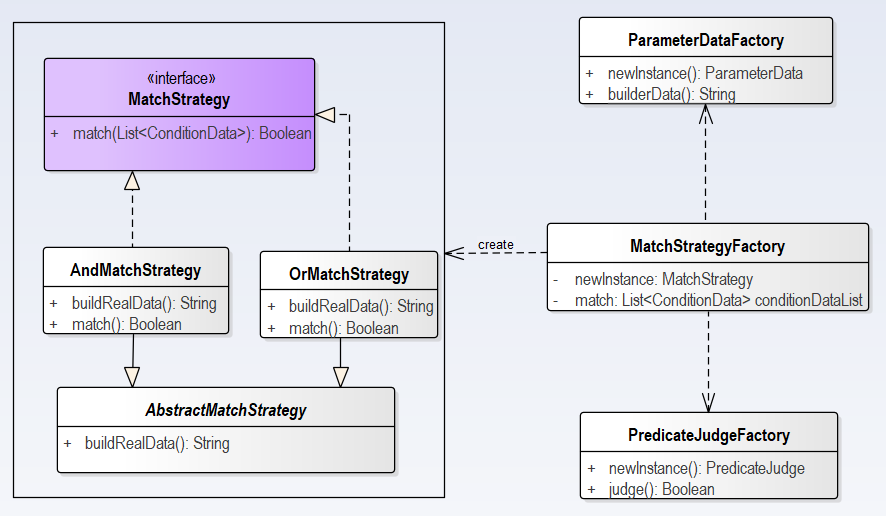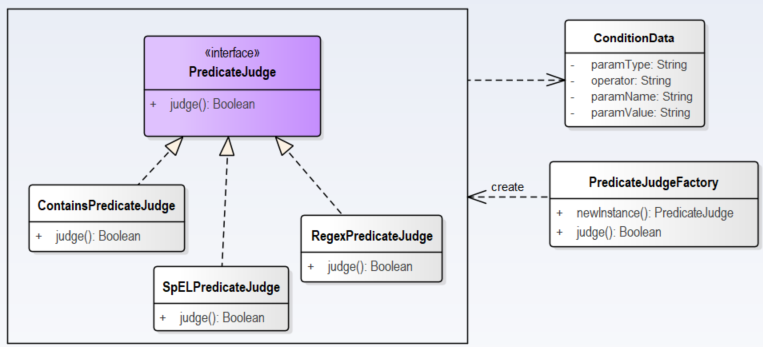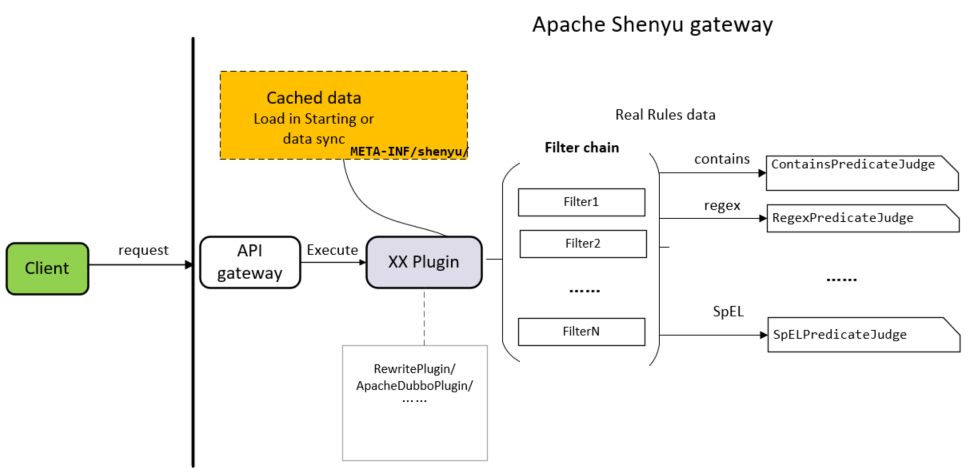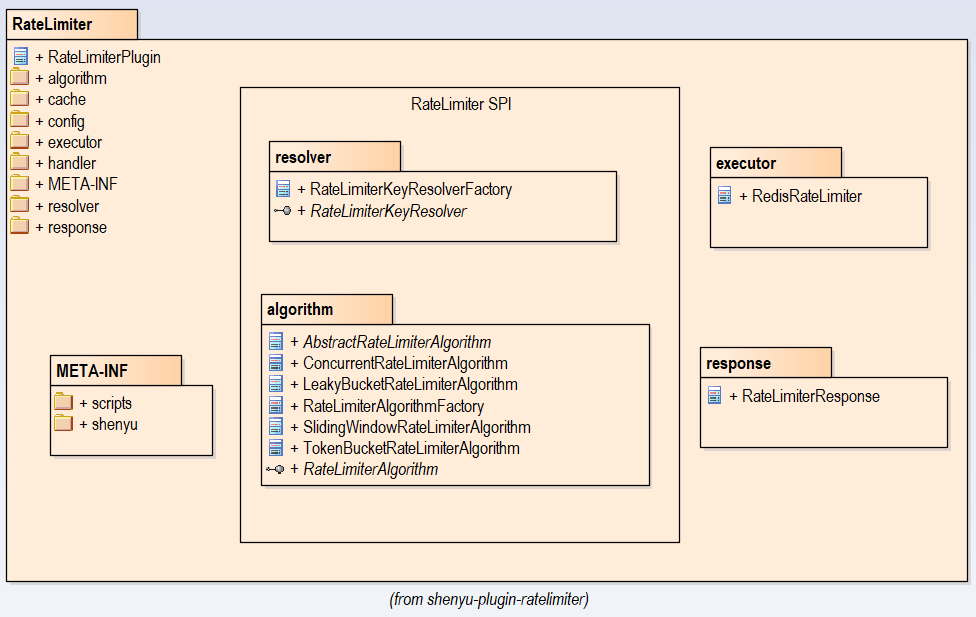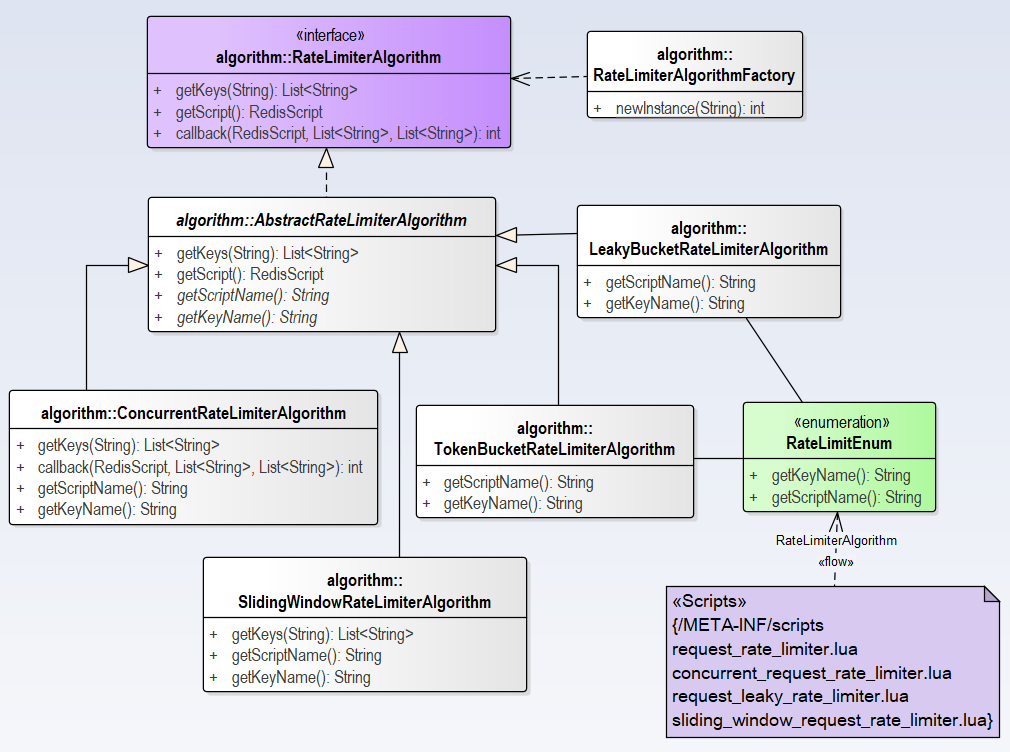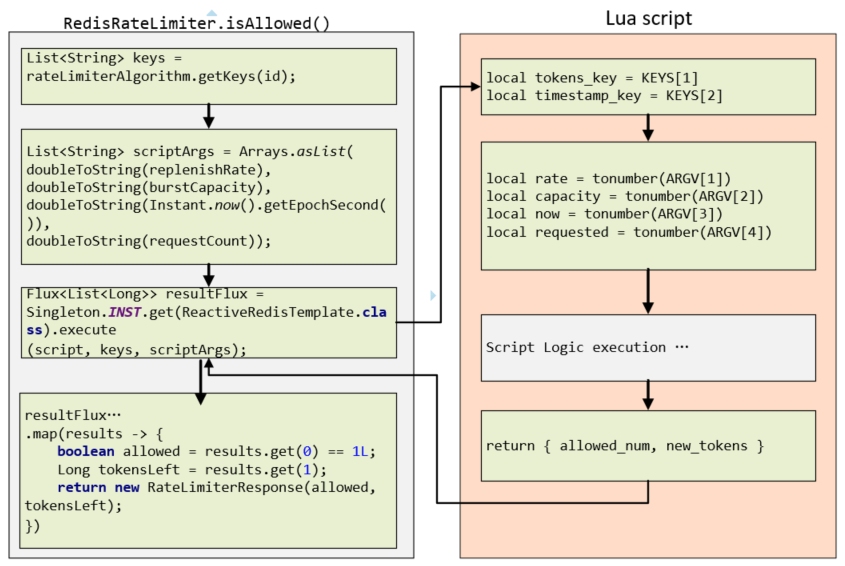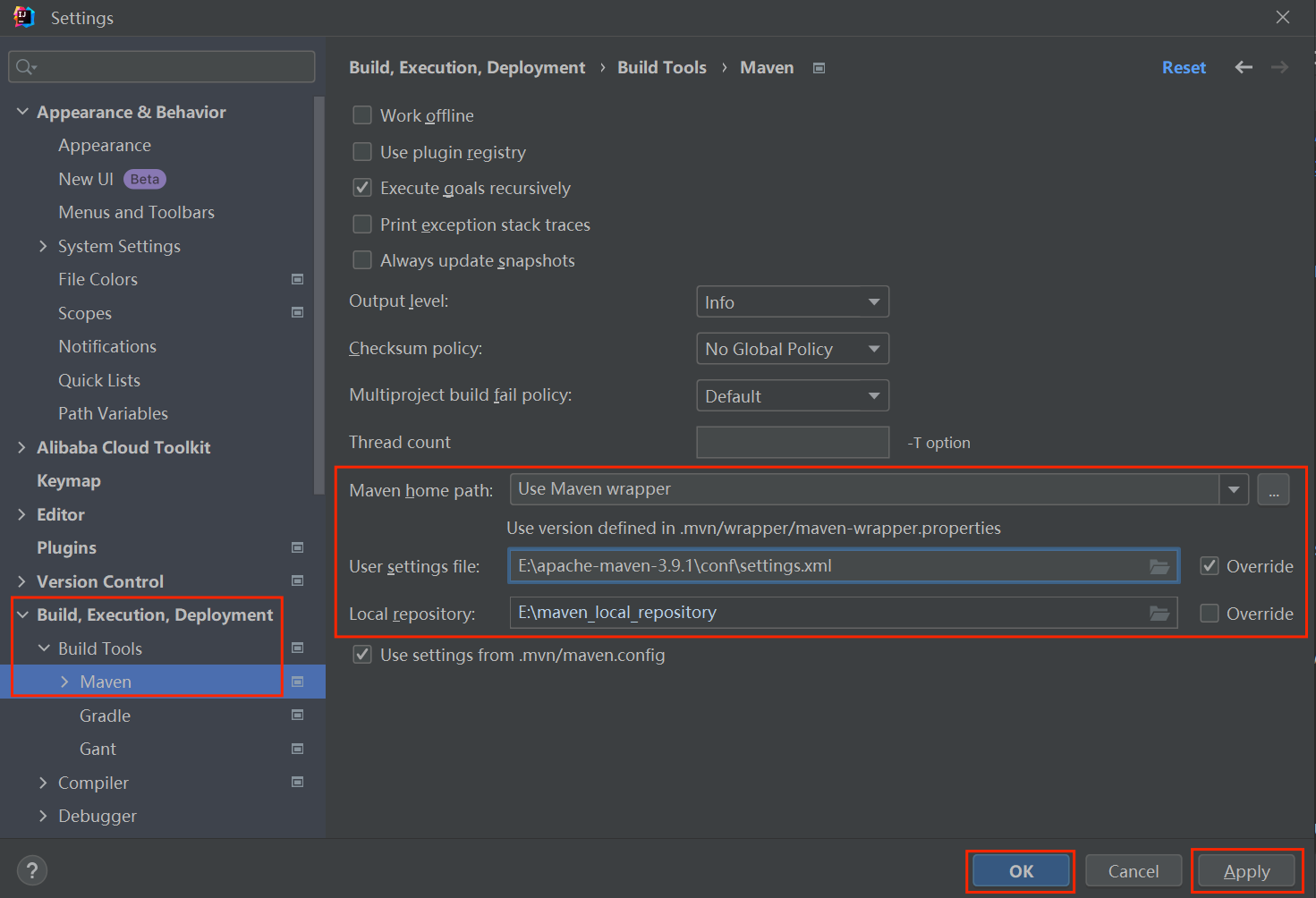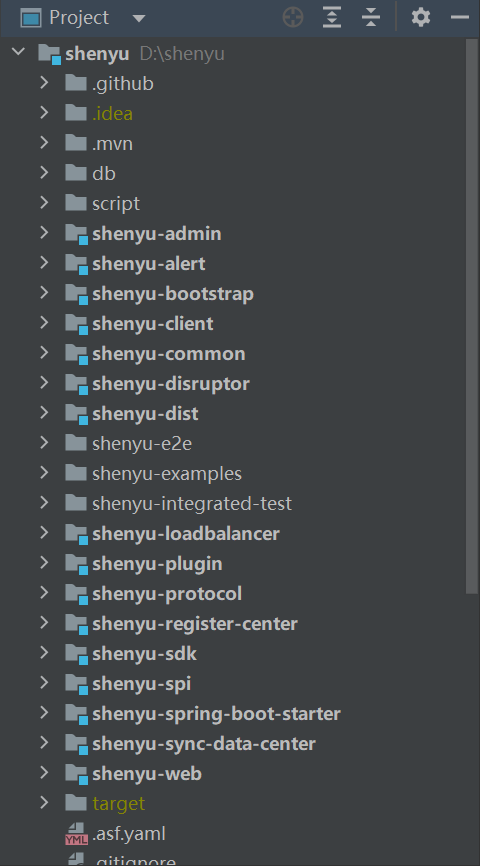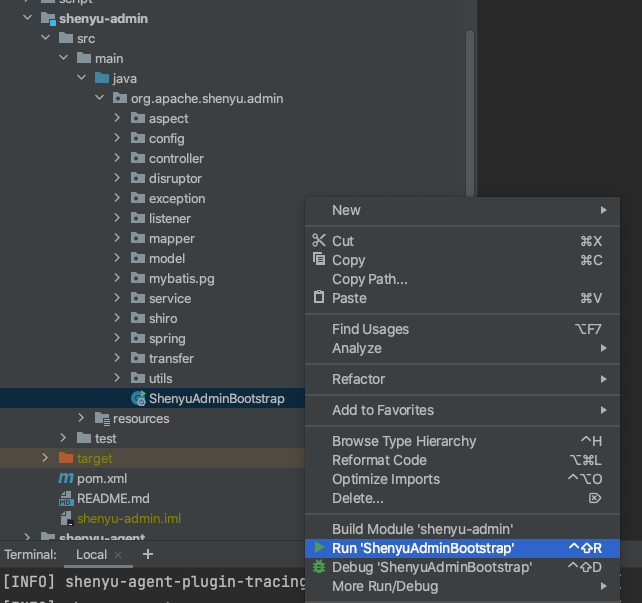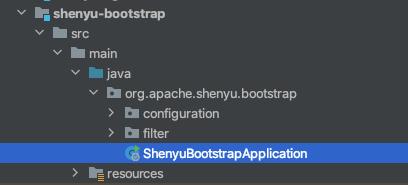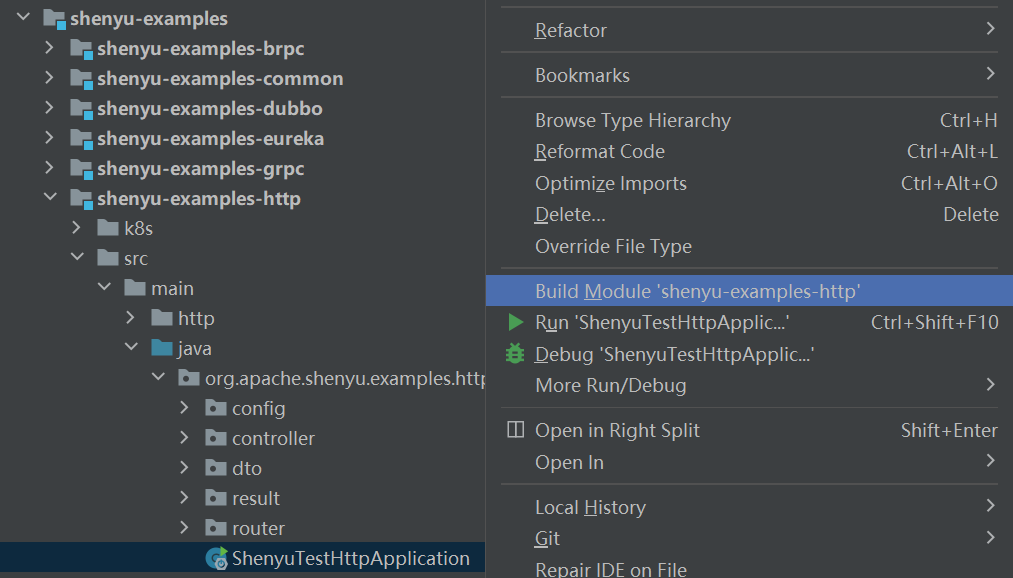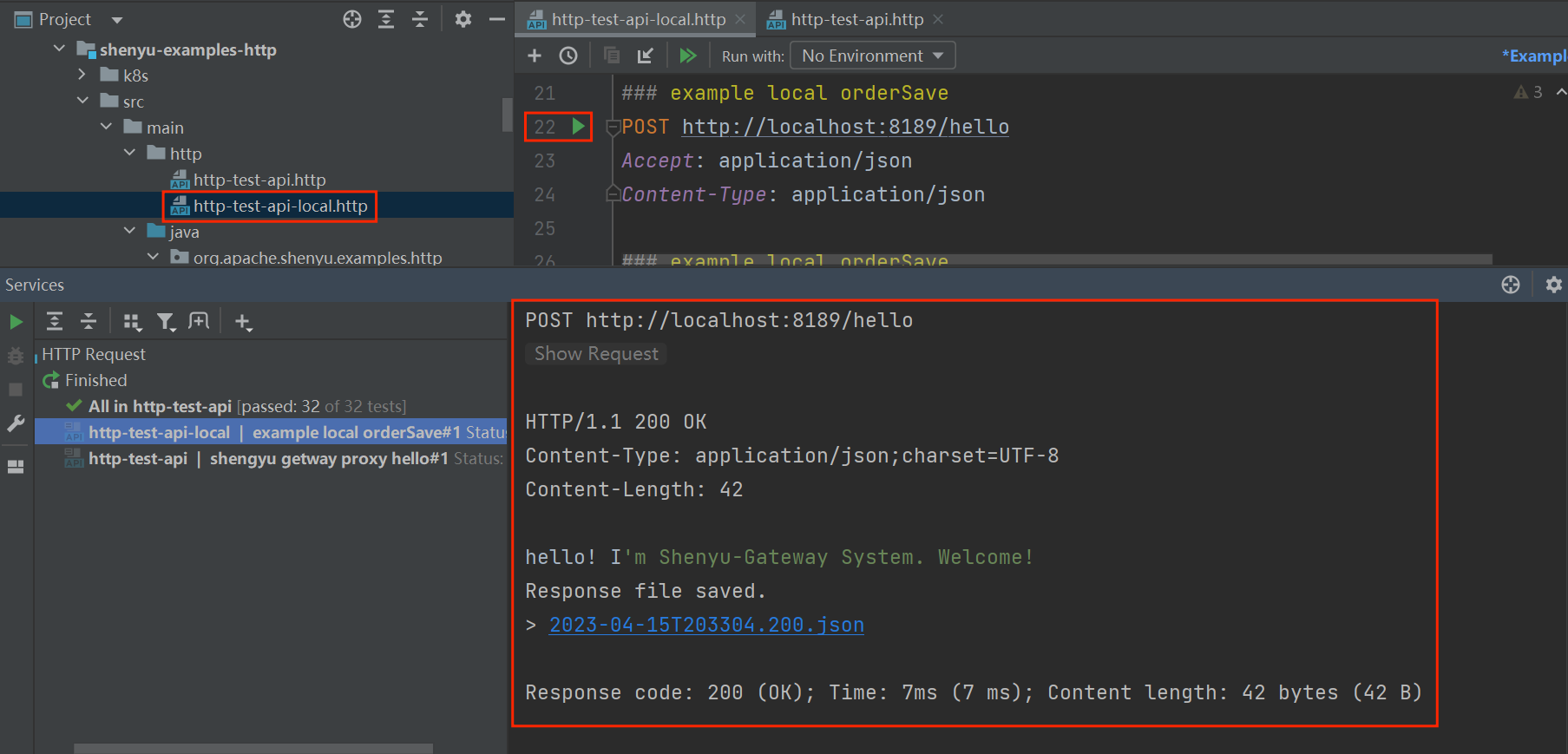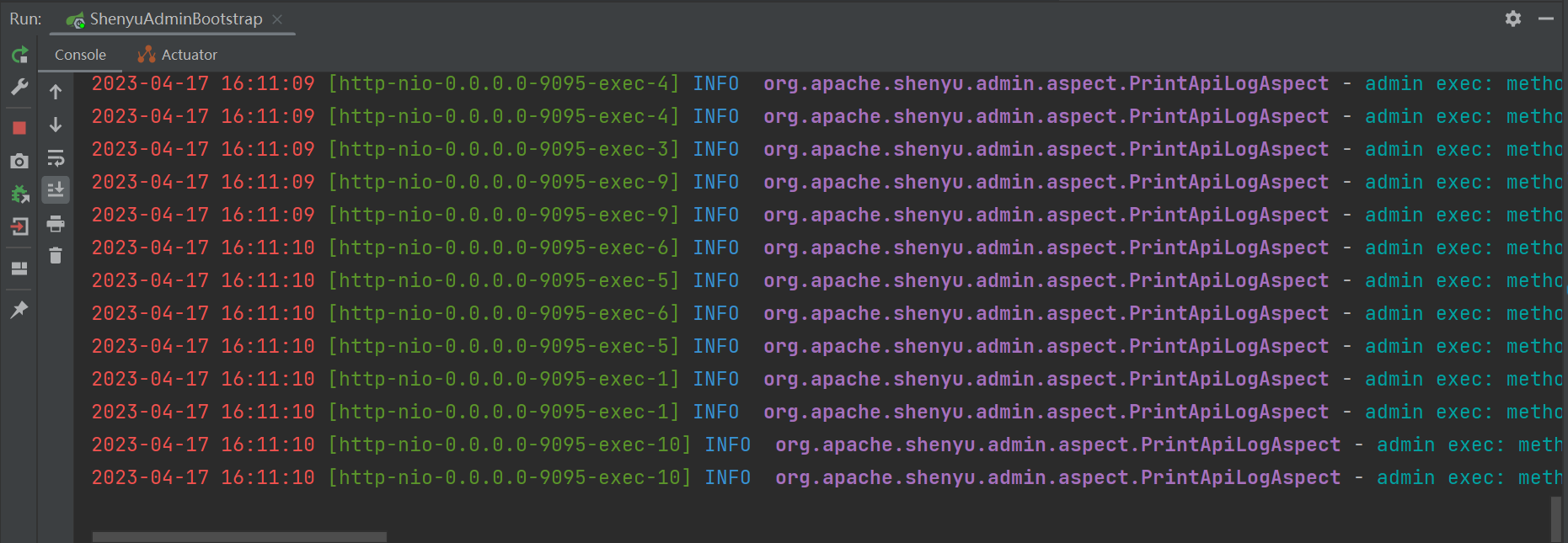Code Analysis For Divide Plugin
The ShenYu gateway uses the divide plugin to handle http requests. You can see the official documentation Quick start with Http to learn how to use this plugin.
This article is based on
shenyu-2.4.3version for source code analysis, please refer to Http Proxy for the introduction of the official website.
1. Register Service
1.1 Declaration of registration interface
Use the annotation @ShenyuSpringMvcClient to register the service to the gateway. The simple demo is as follows.
@RestController
@RequestMapping("/order")
@ShenyuSpringMvcClient(path = "/order") // API
public class OrderController {
@GetMapping("/findById")
@ShenyuSpringMvcClient(path = "/findById", desc = "Find by id") // method
public OrderDTO findById(@RequestParam("id") final String id) {
return build(id, "hello world findById");
}
}
define annotation:
@Retention(RetentionPolicy.RUNTIME)
@Target({ElementType.TYPE, ElementType.METHOD})
public @interface ShenyuSpringMvcClient {
//path
String path() default "";
//rule name
String ruleName() default "";
//desc info
String desc() default "";
//is enabled
boolean enabled() default true;
//register MetaData
boolean registerMetaData() default false;
}
1.2 Scan annotation
Annotation scanning is done through SpringMvcClientBeanPostProcessor, which implements the BeanPostProcessor interface and is a post-processor provided by Spring.
During constructor instantiation.
- Read the property configuration
- Add annotations, read
pathinformation - Start the registry and register with
shenyu-admin
public class SpringMvcClientBeanPostProcessor implements BeanPostProcessor {
//...
/**
* Constructor instantiation
*/
public SpringMvcClientBeanPostProcessor(final PropertiesConfig clientConfig,
final ShenyuClientRegisterRepository shenyuClientRegisterRepository) {
// 1. read Properties
Properties props = clientConfig.getProps();
this.appName = props.getProperty(ShenyuClientConstants.APP_NAME);
this.contextPath = props.getProperty(ShenyuClientConstants.CONTEXT_PATH, "");
if (StringUtils.isBlank(appName) && StringUtils.isBlank(contextPath)) {
String errorMsg = "http register param must config the appName or contextPath";
LOG.error(errorMsg);
throw new ShenyuClientIllegalArgumentException(errorMsg);
}
this.isFull = Boolean.parseBoolean(props.getProperty(ShenyuClientConstants.IS_FULL, Boolean.FALSE.toString()));
// 2. add annotation
mappingAnnotation.add(ShenyuSpringMvcClient.class);
mappingAnnotation.add(PostMapping.class);
mappingAnnotation.add(GetMapping.class);
mappingAnnotation.add(DeleteMapping.class);
mappingAnnotation.add(PutMapping.class);
mappingAnnotation.add(RequestMapping.class);
// 3. start register cneter
publisher.start(shenyuClientRegisterRepository);
}
@Override
public Object postProcessAfterInitialization(@NonNull final Object bean, @NonNull final String beanName) throws BeansException {
// override post process
return bean;
}
- SpringMvcClientBeanPostProcessor#postProcessAfterInitialization()
Rewrite post-processor logic: read annotation information, construct metadata objects and URI objects, and register them with shenyu-admin.
@Override
public Object postProcessAfterInitialization(@NonNull final Object bean, @NonNull final String beanName) throws BeansException {
// 1. If the all service is registered or is not a Controller class, it is not handled
if (Boolean.TRUE.equals(isFull) || !hasAnnotation(bean.getClass(), Controller.class)) {
return bean;
}
// 2. Read the annotations on the class ShenyuSpringMvcClient
final ShenyuSpringMvcClient beanShenyuClient = AnnotationUtils.findAnnotation(bean.getClass(), ShenyuSpringMvcClient.class);
// 2.1 build superPath
final String superPath = buildApiSuperPath(bean.getClass());
// 2.2 whether to register the entire class method
if (Objects.nonNull(beanShenyuClient) && superPath.contains("*")) {
// build the metadata object and register it with shenyu-admin
publisher.publishEvent(buildMetaDataDTO(beanShenyuClient, pathJoin(contextPath, superPath)));
return bean;
}
// 3. read all methods
final Method[] methods = ReflectionUtils.getUniqueDeclaredMethods(bean.getClass());
for (Method method : methods) {
// 3.1 read the annotations on the method ShenyuSpringMvcClient
ShenyuSpringMvcClient methodShenyuClient = AnnotationUtils.findAnnotation(method, ShenyuSpringMvcClient.class);
// If there is no annotation on the method, use the annotation on the class
methodShenyuClient = Objects.isNull(methodShenyuClient) ? beanShenyuClient : methodShenyuClient;
if (Objects.nonNull(methodShenyuClient)) {
// 3.2 Build path information, build metadata objects, register with shenyu-admin
publisher.publishEvent(buildMetaDataDTO(methodShenyuClient, buildApiPath(method, superPath)));
}
}
return bean;
}
-
- If you are registering the whole service or not
Controllerclass, do not handle it
- If you are registering the whole service or not
-
- read the annotation on the class
ShenyuSpringMvcClient, if the whole class is registered, build the metadata object here and register it withshenyu-admin.
- read the annotation on the class
-
- Annotation on the handler method
ShenyuSpringMvcClient, buildpathinformation for the specific method, build the metadata object and then register it withshenyu-admin
- Annotation on the handler method
There are two methods here that take path and need special instructions.
- buildApiSuperPath()
Construct SuperPath: first take the path property from the annotation ShenyuSpringMvcClient on the class, if not, take the path information from the RequestMapping annotation on the current class.
private String buildApiSuperPath(@NonNull final Class<?> method) {
// First take the path property from the annotation ShenyuSpringMvcClient on the class
ShenyuSpringMvcClient shenyuSpringMvcClient = AnnotationUtils.findAnnotation(method, ShenyuSpringMvcClient.class);
if (Objects.nonNull(shenyuSpringMvcClient) && StringUtils.isNotBlank(shenyuSpringMvcClient.path())) {
return shenyuSpringMvcClient.path();
}
// Take the path information from the RequestMapping annotation of the current class
RequestMapping requestMapping = AnnotationUtils.findAnnotation(method, RequestMapping.class);
if (Objects.nonNull(requestMapping) && ArrayUtils.isNotEmpty(requestMapping.path()) && StringUtils.isNotBlank(requestMapping.path()[0])) {
return requestMapping.path()[0];
}
return "";
}
- buildApiPath()
Build path: first read the annotation ShenyuSpringMvcClient on the method and build it if it exists; otherwise get the path information from other annotations on the method; complete path = contextPath(context information) + superPath(class information) + methodPath(method information).
private String buildApiPath(@NonNull final Method method, @NonNull final String superPath) {
// 1. Read the annotation ShenyuSpringMvcClient on the method
ShenyuSpringMvcClient shenyuSpringMvcClient = AnnotationUtils.findAnnotation(method, ShenyuSpringMvcClient.class);
// 1.1 If path exists, build
if (Objects.nonNull(shenyuSpringMvcClient) && StringUtils.isNotBlank(shenyuSpringMvcClient.path())) {
//1.2 path = contextPath+superPath+methodPath
return pathJoin(contextPath, superPath, shenyuSpringMvcClient.path());
}
// 2. Get path information from other annotations on the method
final String path = getPathByMethod(method);
if (StringUtils.isNotBlank(path)) {
// 2.1 path = contextPath+superPath+methodPath
return pathJoin(contextPath, superPath, path);
}
return pathJoin(contextPath, superPath);
}
- getPathByMethod()
Get path information from other annotations on the method, other annotations include.
- ShenyuSpringMvcClient
- PostMapping
- GetMapping
- DeleteMapping
- PutMapping
- RequestMapping
private String getPathByMethod(@NonNull final Method method) {
// Iterate through interface annotations to get path information
for (Class<? extends Annotation> mapping : mappingAnnotation) {
final String pathByAnnotation = getPathByAnnotation(AnnotationUtils.findAnnotation(method, mapping), pathAttributeNames);
if (StringUtils.isNotBlank(pathByAnnotation)) {
return pathByAnnotation;
}
}
return null;
}
After the scanning annotation is finished, construct the metadata object and send the object to shenyu-admin to complete the registration.
- Metadata
Includes the rule information of the currently registered method: contextPath, appName, registration path, description information, registration type, whether it is enabled, rule name and whether to register metadata.
private MetaDataRegisterDTO buildMetaDataDTO(@NonNull final ShenyuSpringMvcClient shenyuSpringMvcClient, final String path) {
return MetaDataRegisterDTO.builder()
.contextPath(contextPath) // contextPath
.appName(appName) // appName
.path(path) // Registered path, used when gateway rules match
.pathDesc(shenyuSpringMvcClient.desc()) // desc info
.rpcType(RpcTypeEnum.HTTP.getName()) // divide plugin, http type when default
.enabled(shenyuSpringMvcClient.enabled()) // is enabled?
.ruleName(StringUtils.defaultIfBlank(shenyuSpringMvcClient.ruleName(), path))//rule name
.registerMetaData(shenyuSpringMvcClient.registerMetaData()) // whether to register metadata information
.build();
}
The specific registration logic is implemented by the registration center, which has been analyzed in the previous articles and will not be analyzed in depth here.
1.3 Register URI Data
ContextRegisterListener is responsible for registering the client's URI information to shenyu-admin, it implements the ApplicationListener interface, when the context refresh event ContextRefreshedEvent occurs, the onApplicationEvent() method is executed to implement the registration logic.
public class ContextRegisterListener implements ApplicationListener<ContextRefreshedEvent>, BeanFactoryAware {
//......
/**
* Constructor instantiation
*/
public ContextRegisterListener(final PropertiesConfig clientConfig) {
// read Properties
final Properties props = clientConfig.getProps();
this.isFull = Boolean.parseBoolean(props.getProperty(ShenyuClientConstants.IS_FULL, Boolean.FALSE.toString()));
this.contextPath = props.getProperty(ShenyuClientConstants.CONTEXT_PATH);
if (Boolean.TRUE.equals(isFull)) {
if (StringUtils.isBlank(contextPath)) {
final String errorMsg = "http register param must config the contextPath";
LOG.error(errorMsg);
throw new ShenyuClientIllegalArgumentException(errorMsg);
}
}
this.port = Integer.parseInt(Optional.ofNullable(props.getProperty(ShenyuClientConstants.PORT)).orElseGet(() -> "-1"));
this.appName = props.getProperty(ShenyuClientConstants.APP_NAME);
this.protocol = props.getProperty(ShenyuClientConstants.PROTOCOL, ShenyuClientConstants.HTTP);
this.host = props.getProperty(ShenyuClientConstants.HOST);
}
@Override
public void setBeanFactory(final BeanFactory beanFactory) throws BeansException {
this.beanFactory = beanFactory;
}
// Execute application events
@Override
public void onApplicationEvent(@NonNull final ContextRefreshedEvent contextRefreshedEvent) {
// The method is guaranteed to be executed once
if (!registered.compareAndSet(false, true)) {
return;
}
// 1. If you are registering for the entire service
if (Boolean.TRUE.equals(isFull)) {
// Build metadata and register
publisher.publishEvent(buildMetaDataDTO());
}
try {
// get port
final int mergedPort = port <= 0 ? PortUtils.findPort(beanFactory) : port;
// 2. Constructing URI data and registering
publisher.publishEvent(buildURIRegisterDTO(mergedPort));
} catch (ShenyuException e) {
throw new ShenyuException(e.getMessage() + "please config ${shenyu.client.http.props.port} in xml/yml !");
}
}
// build URI data
private URIRegisterDTO buildURIRegisterDTO(final int port) {
return URIRegisterDTO.builder()
.contextPath(this.contextPath) // contextPath
.appName(appName) // appName
.protocol(protocol) // protocol
.host(IpUtils.isCompleteHost(this.host) ? this.host : IpUtils.getHost(this.host)) //host
.port(port) // port
.rpcType(RpcTypeEnum.HTTP.getName()) // divide plugin, default registration http type
.build();
}
// build MetaData
private MetaDataRegisterDTO buildMetaDataDTO() {
return MetaDataRegisterDTO.builder()
.contextPath(contextPath)
.appName(appName)
.path(contextPath)
.rpcType(RpcTypeEnum.HTTP.getName())
.enabled(true)
.ruleName(contextPath)
.build();
}
}
1.4 Handle registration information
The metadata and URI data registered by the client through the registry are processed in shenyu-admin, which is responsible for storing to the database and synchronizing to the shenyu gateway. The client registration processing logic of Divide plugin is in ShenyuClientRegisterDivideServiceImpl. The inheritance relationship is as follows.
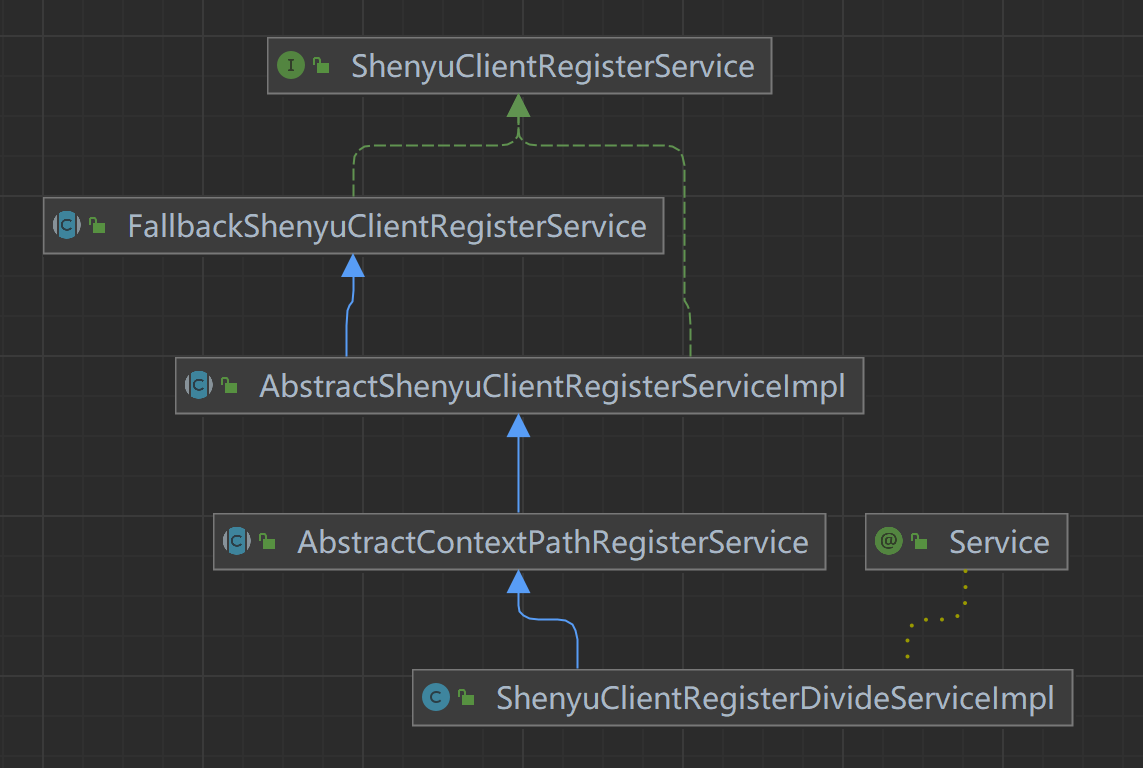
- ShenyuClientRegisterService: client registration service, top-level interface.
- FallbackShenyuClientRegisterService: registration failure, provides retry operation.
- AbstractShenyuClientRegisterServiceImpl: abstract class, implements part of the public registration logic;
- AbstractContextPathRegisterService: abstract class, responsible for registering
ContextPath. - ShenyuClientRegisterDivideServiceImpl: implementation of the
Divideplug-in registration.
1.4.1 Register Service
- org.apache.shenyu.admin.service.register.AbstractShenyuClientRegisterServiceImpl#register()
The metadata MetaDataRegisterDTO object registered by the client through the registry is picked up and dropped in the register() method of shenyu-admin.
@Override
public String register(final MetaDataRegisterDTO dto) {
//1. register selector
String selectorHandler = selectorHandler(dto);
String selectorId = selectorService.registerDefault(dto, PluginNameAdapter.rpcTypeAdapter(rpcType()), selectorHandler);
//2. register rule
String ruleHandler = ruleHandler();
RuleDTO ruleDTO = buildRpcDefaultRuleDTO(selectorId, dto, ruleHandler);
ruleService.registerDefault(ruleDTO);
//3. register metadat
registerMetadata(dto);
//4. register ContextPath
String contextPath = dto.getContextPath();
if (StringUtils.isNotEmpty(contextPath)) {
registerContextPath(dto);
}
return ShenyuResultMessage.SUCCESS;
}
1.4.1.1 Register Selector
- org.apache.shenyu.admin.service.impl.SelectorServiceImpl#registerDefault()
Build contextPath, find if the selector information exists, if it does, return id; if it doesn't, create the default selector information.
@Override
public String registerDefault(final MetaDataRegisterDTO dto, final String pluginName, final String selectorHandler) {
// build contextPath
String contextPath = ContextPathUtils.buildContextPath(dto.getContextPath(), dto.getAppName());
// Find if selector information exists by name
SelectorDO selectorDO = findByNameAndPluginName(contextPath, pluginName);
if (Objects.isNull(selectorDO)) {
// Create a default selector message if it does not exist
return registerSelector(contextPath, pluginName, selectorHandler);
}
return selectorDO.getId();
}
- Default Selector Information
Construct the default selector information and its conditional properties here.
//register selector
private String registerSelector(final String contextPath, final String pluginName, final String selectorHandler) {
// build selector
SelectorDTO selectorDTO = buildSelectorDTO(contextPath, pluginMapper.selectByName(pluginName).getId());
selectorDTO.setHandle(selectorHandler);
//register default Selector
return registerDefault(selectorDTO);
}
//build
private SelectorDTO buildSelectorDTO(final String contextPath, final String pluginId) {
//build default
SelectorDTO selectorDTO = buildDefaultSelectorDTO(contextPath);
selectorDTO.setPluginId(pluginId);
//build the conditional properties of the default selector
selectorDTO.setSelectorConditions(buildDefaultSelectorConditionDTO(contextPath));
return selectorDTO;
}
- Build Default Selector
private SelectorDTO buildDefaultSelectorDTO(final String name) {
return SelectorDTO.builder()
.name(name) // name
.type(SelectorTypeEnum.CUSTOM_FLOW.getCode()) // default CUSTOM_FLOW
.matchMode(MatchModeEnum.AND.getCode()) //default AND
.enabled(Boolean.TRUE) //default TRUE
.loged(Boolean.TRUE) //default TRUE
.continued(Boolean.TRUE) //default TRUE
.sort(1) //default 1
.build();
}
- Build default selector conditional properties
private List<SelectorConditionDTO> buildDefaultSelectorConditionDTO(final String contextPath) {
SelectorConditionDTO selectorConditionDTO = new SelectorConditionDTO();
selectorConditionDTO.setParamType(ParamTypeEnum.URI.getName()); // default URI
selectorConditionDTO.setParamName("/");
selectorConditionDTO.setOperator(OperatorEnum.MATCH.getAlias()); // default match
selectorConditionDTO.setParamValue(contextPath + AdminConstants.URI_SUFFIX); // default /contextPath/**
return Collections.singletonList(selectorConditionDTO);
}
- Register default selector
@Override
public String registerDefault(final SelectorDTO selectorDTO) {
//selector info
SelectorDO selectorDO = SelectorDO.buildSelectorDO(selectorDTO);
//selector condition info
List<SelectorConditionDTO> selectorConditionDTOs = selectorDTO.getSelectorConditions();
if (StringUtils.isEmpty(selectorDTO.getId())) {
// insert selector information into the database
selectorMapper.insertSelective(selectorDO);
// insert selector condition information into the database
selectorConditionDTOs.forEach(selectorConditionDTO -> {
selectorConditionDTO.setSelectorId(selectorDO.getId());
selectorConditionMapper.insertSelective(SelectorConditionDO.buildSelectorConditionDO(selectorConditionDTO));
});
}
// Publish synchronization events to synchronize selection information and its conditional attributes to the gateway
publishEvent(selectorDO, selectorConditionDTOs);
return selectorDO.getId();
}
1.4.1.2 Register Rule
In the second step of registering the service, start building the default rules and then register the rules.
@Override
public String register(final MetaDataRegisterDTO dto) {
//1. register selector
//......
//2. register rule
// default rule handle
String ruleHandler = ruleHandler();
// build default rule
RuleDTO ruleDTO = buildRpcDefaultRuleDTO(selectorId, dto, ruleHandler);
// register rule
ruleService.registerDefault(ruleDTO);
//3. register Metadata
//......
//4. register ContextPath
//......
return ShenyuResultMessage.SUCCESS;
}
- default rule handle
@Override
protected String ruleHandler() {
// default rule handle
return new DivideRuleHandle().toJson();
}
Divide plugin default rule handle.
public class DivideRuleHandle implements RuleHandle {
/**
* load balance: default RANDOM
*/
private String loadBalance = LoadBalanceEnum.RANDOM.getName();
/**
* retry strategy: default CURRENT
*/
private String retryStrategy = RetryEnum.CURRENT.getName();
/**
* retry: default 3
*/
private int retry = 3;
/**
* retry: default 3000
*/
private long timeout = Constants.TIME_OUT;
/**
* retry: default 10240 byte
*/
private long headerMaxSize = Constants.HEADER_MAX_SIZE;
/**
* retry: default 102400 byte
*/
private long requestMaxSize = Constants.REQUEST_MAX_SIZE;
}
- build default rule info
// build default rule info
private RuleDTO buildRpcDefaultRuleDTO(final String selectorId, final MetaDataRegisterDTO metaDataDTO, final String ruleHandler) {
return buildRuleDTO(selectorId, ruleHandler, metaDataDTO.getRuleName(), metaDataDTO.getPath());
}
// build default rule info
private RuleDTO buildRuleDTO(final String selectorId, final String ruleHandler, final String ruleName, final String path) {
RuleDTO ruleDTO = RuleDTO.builder()
.selectorId(selectorId) //selector Id
.name(ruleName) //rule Name
.matchMode(MatchModeEnum.AND.getCode()) // default and
.enabled(Boolean.TRUE) // default TRUE
.loged(Boolean.TRUE) //default TRUE
.sort(1) //default 1
.handle(ruleHandler)
.build();
RuleConditionDTO ruleConditionDTO = RuleConditionDTO.builder()
.paramType(ParamTypeEnum.URI.getName()) // default URI
.paramName("/")
.paramValue(path) // path
.build();
if (path.indexOf("*") > 1) {
ruleConditionDTO.setOperator(OperatorEnum.MATCH.getAlias()); //if the path conatins *, default match
} else {
ruleConditionDTO.setOperator(OperatorEnum.EQ.getAlias()); // default =
}
ruleDTO.setRuleConditions(Collections.singletonList(ruleConditionDTO));
return ruleDTO;
}
- org.apache.shenyu.admin.service.impl.RuleServiceImpl#registerDefault()
Registration rules: insert records to the database and publish events to the gateway for data synchronization.
@Override
public String registerDefault(final RuleDTO ruleDTO) {
RuleDO exist = ruleMapper.findBySelectorIdAndName(ruleDTO.getSelectorId(), ruleDTO.getName());
if (Objects.nonNull(exist)) {
return "";
}
RuleDO ruleDO = RuleDO.buildRuleDO(ruleDTO);
List<RuleConditionDTO> ruleConditions = ruleDTO.getRuleConditions();
if (StringUtils.isEmpty(ruleDTO.getId())) {
// insert rule into database
ruleMapper.insertSelective(ruleDO);
//insert rule condition into database
ruleConditions.forEach(ruleConditionDTO -> {
ruleConditionDTO.setRuleId(ruleDO.getId());
ruleConditionMapper.insertSelective(RuleConditionDO.buildRuleConditionDO(ruleConditionDTO));
});
}
// Publish events to the gateway for data synchronization
publishEvent(ruleDO, ruleConditions);
return ruleDO.getId();
}
1.4.1.3 Register Metadata
@Override
public String register(final MetaDataRegisterDTO dto) {
//1. register selector
//......
//2. register rule
//......
//3. register metadata
registerMetadata(dto);
//4. register ContextPath
//......
return ShenyuResultMessage.SUCCESS;
}
- org.apache.shenyu.admin.service.register.ShenyuClientRegisterDivideServiceImpl#registerMetadata()
Insert or update metadata and then publish sync events to the gateway.
@Override
protected void registerMetadata(final MetaDataRegisterDTO dto) {
if (dto.isRegisterMetaData()) {
MetaDataService metaDataService = getMetaDataService();
MetaDataDO exist = metaDataService.findByPath(dto.getPath());
// save or update MetaData
metaDataService.saveOrUpdateMetaData(exist, dto);
}
}
@Override
public void saveOrUpdateMetaData(final MetaDataDO exist, final MetaDataRegisterDTO metaDataDTO) {
DataEventTypeEnum eventType;
// DTO->DO
MetaDataDO metaDataDO = MetaDataTransfer.INSTANCE.mapRegisterDTOToEntity(metaDataDTO);
// insert
if (Objects.isNull(exist)) {
Timestamp currentTime = new Timestamp(System.currentTimeMillis());
metaDataDO.setId(UUIDUtils.getInstance().generateShortUuid());
metaDataDO.setDateCreated(currentTime);
metaDataDO.setDateUpdated(currentTime);
metaDataMapper.insert(metaDataDO);
eventType = DataEventTypeEnum.CREATE;
} else {
// update
metaDataDO.setId(exist.getId());
metaDataMapper.update(metaDataDO);
eventType = DataEventTypeEnum.UPDATE;
}
// publish event to gateway
eventPublisher.publishEvent(new DataChangedEvent(ConfigGroupEnum.META_DATA, eventType,
Collections.singletonList(MetaDataTransfer.INSTANCE.mapToData(metaDataDO))));
}
1.4.1.4 Register ContextPath
@Override
public String register(final MetaDataRegisterDTO dto) {
//1. register selector
//......
//2. register rule
//......
//3. register metadata
//......
//4. register ContextPath
String contextPath = dto.getContextPath();
if (StringUtils.isNotEmpty(contextPath)) {
registerContextPath(dto);
}
return ShenyuResultMessage.SUCCESS;
}
- org.apache.shenyu.admin.service.register.AbstractContextPathRegisterService#registerContextPath()
@Override
public void registerContextPath(final MetaDataRegisterDTO dto) {
// set contextPath for selector
String contextPathSelectorId = getSelectorService().registerDefault(dto, PluginEnum.CONTEXT_PATH.getName(), "");
ContextMappingRuleHandle handle = new ContextMappingRuleHandle();
handle.setContextPath(PathUtils.decoratorContextPath(dto.getContextPath()));
// set contextPath for rule
getRuleService().registerDefault(buildContextPathDefaultRuleDTO(contextPathSelectorId, dto, handle.toJson()));
}
1.4.2 Register URI
- org.apache.shenyu.admin.service.register.FallbackShenyuClientRegisterService#registerURI()
The server side receives the URI information registered by the client and processes it.
@Override
public String registerURI(final String selectorName, final List<URIRegisterDTO> uriList) {
String result;
String key = key(selectorName);
try {
this.removeFallBack(key);
// register URI
result = this.doRegisterURI(selectorName, uriList);
logger.info("Register success: {},{}", selectorName, uriList);
} catch (Exception ex) {
logger.warn("Register exception: cause:{}", ex.getMessage());
result = "";
// Retry after registration failure
this.addFallback(key, new FallbackHolder(selectorName, uriList));
}
return result;
}
- org.apache.shenyu.admin.service.register.AbstractShenyuClientRegisterServiceImpl#doRegisterURI()
Get a valid URI from the URI registered by the client, update the corresponding selector handle property, and send a selector update event to the gateway.
@Override
public String doRegisterURI(final String selectorName, final List<URIRegisterDTO> uriList) {
//check
if (CollectionUtils.isEmpty(uriList)) {
return "";
}
//get selector
SelectorDO selectorDO = selectorService.findByNameAndPluginName(selectorName, PluginNameAdapter.rpcTypeAdapter(rpcType()));
if (Objects.isNull(selectorDO)) {
throw new ShenyuException("doRegister Failed to execute,wait to retry.");
}
// gte valid URI
List<URIRegisterDTO> validUriList = uriList.stream().filter(dto -> Objects.nonNull(dto.getPort()) && StringUtils.isNotBlank(dto.getHost())).collect(Collectors.toList());
// build handle
String handler = buildHandle(validUriList, selectorDO);
if (handler != null) {
selectorDO.setHandle(handler);
SelectorData selectorData = selectorService.buildByName(selectorName, PluginNameAdapter.rpcTypeAdapter(rpcType()));
selectorData.setHandle(handler);
// Update the handle property of the selector to the database
selectorService.updateSelective(selectorDO);
// Send selector update events to the gateway
eventPublisher.publishEvent(new DataChangedEvent(ConfigGroupEnum.SELECTOR, DataEventTypeEnum.UPDATE, Collections.singletonList(selectorData)));
}
return ShenyuResultMessage.SUCCESS;
}
The source code analysis on service registration is completed as well as the analysis flow chart is as follows.

The next step is to analyze how the divide plugin initiates a call to the http service based on this information.
2. Call Http Service
The divide plugin is the core processing plugin used by the gateway to handle http protocol requests.
Take the case provided on the official website Quick start with Http as an example, a direct connection request is as follows.
GET http://localhost:8189/order/findById?id=100
Accept: application/json
After proxying through the ShenYu gateway, the request is as follows.
GET http://localhost:9195/http/order/findById?id=100
Accept: application/json
The services proxied by the ShenYu gateway are still able to request the previous services, where the divide plugin comes into play. The class inheritance relationship is as follows.
- ShenyuPlugin: top-level interface, defining interface methods.
- AbstractShenyuPlugin: abstract class that implements the common logic of the pluin.
- DividePlugin: Divide pluin.
2.1 Accept Request
After passing the ShenYu gateway proxy, the request entry is ShenyuWebHandler, which implements the org.springframework.web.server.WebHandler interface.
public final class ShenyuWebHandler implements WebHandler, ApplicationListener<SortPluginEvent> {
//......
/**
* hanlde web reuest
*/
@Override
public Mono<Void> handle(@NonNull final ServerWebExchange exchange) {
// execute plugin chain
Mono<Void> execute = new DefaultShenyuPluginChain(plugins).execute(exchange);
if (scheduled) {
return execute.subscribeOn(scheduler);
}
return execute;
}
private static class DefaultShenyuPluginChain implements ShenyuPluginChain {
private int index;
private final List<ShenyuPlugin> plugins;
/**
* Instantiating the default plugin chain
*/
DefaultShenyuPluginChain(final List<ShenyuPlugin> plugins) {
this.plugins = plugins;
}
/**
* Execute each plugin
*/
@Override
public Mono<Void> execute(final ServerWebExchange exchange) {
return Mono.defer(() -> {
if (this.index < plugins.size()) {
// get current plugin
ShenyuPlugin plugin = plugins.get(this.index++);
// is skip ?
boolean skip = plugin.skip(exchange);
if (skip) {
// If skipped, execute the next
return this.execute(exchange);
}
// execute current plugin
return plugin.execute(exchange, this);
}
return Mono.empty();
});
}
}
}
2.2 Matching rule
- org.apache.shenyu.plugin.base.AbstractShenyuPlugin#execute()
Execute the matching logic for selectors and rules in the execute() method.
- Matching selectors.
- Matching rules.
- Execute the plugin.
@Override
public Mono<Void> execute(final ServerWebExchange exchange, final ShenyuPluginChain chain) {
String pluginName = named();
PluginData pluginData = BaseDataCache.getInstance().obtainPluginData(pluginName);
if (pluginData != null && pluginData.getEnabled()) {
// selector
final Collection<SelectorData> selectors = BaseDataCache.getInstance().obtainSelectorData(pluginName);
if (CollectionUtils.isEmpty(selectors)) {
return handleSelectorIfNull(pluginName, exchange, chain);
}
// match selector
SelectorData selectorData = matchSelector(exchange, selectors);
if (Objects.isNull(selectorData)) {
return handleSelectorIfNull(pluginName, exchange, chain);
}
selectorLog(selectorData, pluginName);
// rule
List<RuleData> rules = BaseDataCache.getInstance().obtainRuleData(selectorData.getId());
if (CollectionUtils.isEmpty(rules)) {
return handleRuleIfNull(pluginName, exchange, chain);
}
// match rule
RuleData rule;
if (selectorData.getType() == SelectorTypeEnum.FULL_FLOW.getCode()) {
//get last
rule = rules.get(rules.size() - 1);
} else {
rule = matchRule(exchange, rules);
}
if (Objects.isNull(rule)) {
return handleRuleIfNull(pluginName, exchange, chain);
}
ruleLog(rule, pluginName);
// execute
return doExecute(exchange, chain, selectorData, rule);
}
return chain.execute(exchange);
}
2.3 Execute Divide Plugin
- org.apache.shenyu.plugin.divide.DividePlugin#doExecute()
Execute the specific logic of the divide plugin in the doExecute() method.
- Checks the
headersize. - Checking the
requestsize. - Obtaining the list of services.
- implementing load balancing.
- Set request
url, timeout time, retry policy.
@Override
protected Mono<Void> doExecute(final ServerWebExchange exchange, final ShenyuPluginChain chain, final SelectorData selector, final RuleData rule) {
// shenyu Context
ShenyuContext shenyuContext = exchange.getAttribute(Constants.CONTEXT);
assert shenyuContext != null;
// Get the handle property of the rule
DivideRuleHandle ruleHandle = DividePluginDataHandler.CACHED_HANDLE.get().obtainHandle(CacheKeyUtils.INST.getKey(rule));
long headerSize = 0;
// check header size
for (List<String> multiHeader : exchange.getRequest().getHeaders().values()) {
for (String value : multiHeader) {
headerSize += value.getBytes(StandardCharsets.UTF_8).length;
}
}
if (headerSize > ruleHandle.getHeaderMaxSize()) {
LOG.error("request header is too large");
Object error = ShenyuResultWrap.error(exchange, ShenyuResultEnum.REQUEST_HEADER_TOO_LARGE, null);
return WebFluxResultUtils.result(exchange, error);
}
// check request size
if (exchange.getRequest().getHeaders().getContentLength() > ruleHandle.getRequestMaxSize()) {
LOG.error("request entity is too large");
Object error = ShenyuResultWrap.error(exchange, ShenyuResultEnum.REQUEST_ENTITY_TOO_LARGE, null);
return WebFluxResultUtils.result(exchange, error);
}
// upstream list
List<Upstream> upstreamList = UpstreamCacheManager.getInstance().findUpstreamListBySelectorId(selector.getId());
if (CollectionUtils.isEmpty(upstreamList)) {
LOG.error("divide upstream configuration error: {}", rule);
Object error = ShenyuResultWrap.error(exchange, ShenyuResultEnum.CANNOT_FIND_HEALTHY_UPSTREAM_URL, null);
return WebFluxResultUtils.result(exchange, error);
}
// request ip
String ip = Objects.requireNonNull(exchange.getRequest().getRemoteAddress()).getAddress().getHostAddress();
// load balance
Upstream upstream = LoadBalancerFactory.selector(upstreamList, ruleHandle.getLoadBalance(), ip);
if (Objects.isNull(upstream)) {
LOG.error("divide has no upstream");
Object error = ShenyuResultWrap.error(exchange, ShenyuResultEnum.CANNOT_FIND_HEALTHY_UPSTREAM_URL, null);
return WebFluxResultUtils.result(exchange, error);
}
// set url
String domain = upstream.buildDomain();
exchange.getAttributes().put(Constants.HTTP_DOMAIN, domain);
// set timeout
exchange.getAttributes().put(Constants.HTTP_TIME_OUT, ruleHandle.getTimeout());
exchange.getAttributes().put(Constants.HTTP_RETRY, ruleHandle.getRetry());
// set retry
exchange.getAttributes().put(Constants.RETRY_STRATEGY, ruleHandle.getRetryStrategy());
exchange.getAttributes().put(Constants.LOAD_BALANCE, ruleHandle.getLoadBalance());
exchange.getAttributes().put(Constants.DIVIDE_SELECTOR_ID, selector.getId());
return chain.execute(exchange);
}
2.4 Do Request
By default, the WebClientPlugin initiates a call request to the http service with the following class inheritance relationship.
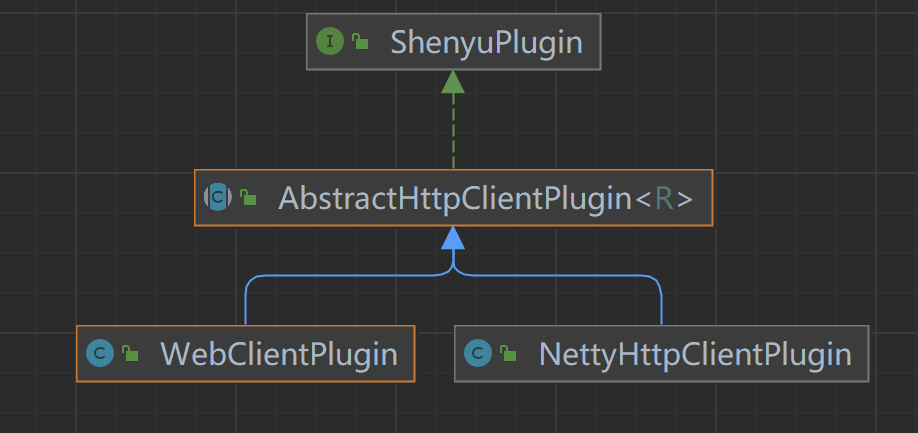
- ShenyuPlugin: top-level plug-in, defining plug-in methods.
- AbstractHttpClientPlugin: abstract class that implements the public logic of request invocation.
- WebClientPlugin: initiating requests through
WebClient. - NettyHttpClientPlugin: initiating requests through
Netty.
Initiate the request call.
- org.apache.shenyu.plugin.httpclient.AbstractHttpClientPlugin#execute()
Initiate the request call in the execute() method.
- Get the specified timeout, number of retries
- Initiate the request
- Retry after failure according to the specified retry policy
public abstract class AbstractHttpClientPlugin<R> implements ShenyuPlugin {
protected static final Logger LOG = LoggerFactory.getLogger(AbstractHttpClientPlugin.class);
@Override
public final Mono<Void> execute(final ServerWebExchange exchange, final ShenyuPluginChain chain) {
// shenyu Context
final ShenyuContext shenyuContext = exchange.getAttribute(Constants.CONTEXT);
assert shenyuContext != null;
// uri
final URI uri = exchange.getAttribute(Constants.HTTP_URI);
if (Objects.isNull(uri)) {
Object error = ShenyuResultWrap.error(exchange, ShenyuResultEnum.CANNOT_FIND_URL, null);
return WebFluxResultUtils.result(exchange, error);
}
// get time out
final long timeout = (long) Optional.ofNullable(exchange.getAttribute(Constants.HTTP_TIME_OUT)).orElse(3000L);
final Duration duration = Duration.ofMillis(timeout);
// get retry times
final int retryTimes = (int) Optional.ofNullable(exchange.getAttribute(Constants.HTTP_RETRY)).orElse(0);
// get retry strategy
final String retryStrategy = (String) Optional.ofNullable(exchange.getAttribute(Constants.RETRY_STRATEGY)).orElseGet(RetryEnum.CURRENT::getName);
LOG.info("The request urlPath is {}, retryTimes is {}, retryStrategy is {}", uri.toASCIIString(), retryTimes, retryStrategy);
// build header
final HttpHeaders httpHeaders = buildHttpHeaders(exchange);
// do request
final Mono<R> response = doRequest(exchange, exchange.getRequest().getMethodValue(), uri, httpHeaders, exchange.getRequest().getBody())
.timeout(duration, Mono.error(new TimeoutException("Response took longer than timeout: " + duration)))
.doOnError(e -> LOG.error(e.getMessage(), e));
// Retry Policy CURRENT, retries the current service.
if (RetryEnum.CURRENT.getName().equals(retryStrategy)) {
//old version of DividePlugin and SpringCloudPlugin will run on this
return response.retryWhen(Retry.anyOf(TimeoutException.class, ConnectTimeoutException.class, ReadTimeoutException.class, IllegalStateException.class)
.retryMax(retryTimes)
.backoff(Backoff.exponential(Duration.ofMillis(200), Duration.ofSeconds(20), 2, true)))
.onErrorMap(TimeoutException.class, th -> new ResponseStatusException(HttpStatus.GATEWAY_TIMEOUT, th.getMessage(), th))
.flatMap((Function<Object, Mono<? extends Void>>) o -> chain.execute(exchange));
}
// Retry for other services
// Exclude services that have already been called
final Set<URI> exclude = Sets.newHashSet(uri);
// resend
return resend(response, exchange, duration, httpHeaders, exclude, retryTimes)
.onErrorMap(TimeoutException.class, th -> new ResponseStatusException(HttpStatus.GATEWAY_TIMEOUT, th.getMessage(), th))
.flatMap((Function<Object, Mono<? extends Void>>) o -> chain.execute(exchange));
}
private Mono<R> resend(final Mono<R> clientResponse,
final ServerWebExchange exchange,
final Duration duration,
final HttpHeaders httpHeaders,
final Set<URI> exclude,
final int retryTimes) {
Mono<R> result = clientResponse;
// Retry according to the specified number of retries
for (int i = 0; i < retryTimes; i++) {
result = resend(result, exchange, duration, httpHeaders, exclude);
}
return result;
}
private Mono<R> resend(final Mono<R> response,
final ServerWebExchange exchange,
final Duration duration,
final HttpHeaders httpHeaders,
final Set<URI> exclude) {
return response.onErrorResume(th -> {
final String selectorId = exchange.getAttribute(Constants.DIVIDE_SELECTOR_ID);
final String loadBalance = exchange.getAttribute(Constants.LOAD_BALANCE);
//Check available services
final List<Upstream> upstreamList = UpstreamCacheManager.getInstance().findUpstreamListBySelectorId(selectorId)
.stream().filter(data -> {
final String trimUri = data.getUrl().trim();
for (URI needToExclude : exclude) {
// exclude already called
if ((needToExclude.getHost() + ":" + needToExclude.getPort()).equals(trimUri)) {
return false;
}
}
return true;
}).collect(Collectors.toList());
if (CollectionUtils.isEmpty(upstreamList)) {
// no need to retry anymore
return Mono.error(new ShenyuException(ShenyuResultEnum.CANNOT_FIND_HEALTHY_UPSTREAM_URL_AFTER_FAILOVER.getMsg()));
}
// requets ip
final String ip = Objects.requireNonNull(exchange.getRequest().getRemoteAddress()).getAddress().getHostAddress();
// Load Balance
final Upstream upstream = LoadBalancerFactory.selector(upstreamList, loadBalance, ip);
if (Objects.isNull(upstream)) {
// no need to retry anymore
return Mono.error(new ShenyuException(ShenyuResultEnum.CANNOT_FIND_HEALTHY_UPSTREAM_URL_AFTER_FAILOVER.getMsg()));
}
final URI newUri = RequestUrlUtils.buildRequestUri(exchange, upstream.buildDomain());
// Exclude uri that has already been called
exclude.add(newUri);
// Make another call
return doRequest(exchange, exchange.getRequest().getMethodValue(), newUri, httpHeaders, exchange.getRequest().getBody())
.timeout(duration, Mono.error(new TimeoutException("Response took longer than timeout: " + duration)))
.doOnError(e -> LOG.error(e.getMessage(), e));
});
}
//......
}
- org.apache.shenyu.plugin.httpclient.WebClientPlugin#doRequest()
Initiate a real request call via webClient in the doRequest() method.
@Override
protected Mono<ClientResponse> doRequest(final ServerWebExchange exchange, final String httpMethod, final URI uri,
final HttpHeaders httpHeaders, final Flux<DataBuffer> body) {
return webClient.method(HttpMethod.valueOf(httpMethod)).uri(uri) // uri
.headers(headers -> headers.addAll(httpHeaders)) // header
.body(BodyInserters.fromDataBuffers(body))
.exchange() // request
.doOnSuccess(res -> {
if (res.statusCode().is2xxSuccessful()) { // success
exchange.getAttributes().put(Constants.CLIENT_RESPONSE_RESULT_TYPE, ResultEnum.SUCCESS.getName());
} else { // error
exchange.getAttributes().put(Constants.CLIENT_RESPONSE_RESULT_TYPE, ResultEnum.ERROR.getName());
}
exchange.getResponse().setStatusCode(res.statusCode());
exchange.getAttributes().put(Constants.CLIENT_RESPONSE_ATTR, res);
});
}
2.5 Response Result
- org.apache.shenyu.plugin.response.ResponsePlugin#execute()
The response results are handled by the ResponsePlugin plugin.
@Override
public Mono<Void> execute(final ServerWebExchange exchange, final ShenyuPluginChain chain) {
ShenyuContext shenyuContext = exchange.getAttribute(Constants.CONTEXT);
assert shenyuContext != null;
// Processing results according to rpc type
return writerMap.get(shenyuContext.getRpcType()).writeWith(exchange, chain);
}
The processing type is determined by MessageWriter and the class inheritance relationship is as follows.

- MessageWriter: interface, defining message processing methods.
- NettyClientMessageWriter: processing of
Nettycall results. - RPCMessageWriter: processing the results of
RPCcalls. - WebClientMessageWriter: processing
WebClientcall results.
The default is to initiate http requests via WebCient.
- org.apache.shenyu.plugin.response.strategy.WebClientMessageWriter#writeWith()
Process the response results in the writeWith() method.
@Override
public Mono<Void> writeWith(final ServerWebExchange exchange, final ShenyuPluginChain chain) {
return chain.execute(exchange).then(Mono.defer(() -> {
// get response
ServerHttpResponse response = exchange.getResponse();
ClientResponse clientResponse = exchange.getAttribute(Constants.CLIENT_RESPONSE_ATTR);
if (Objects.isNull(clientResponse)) {
Object error = ShenyuResultWrap.error(exchange, ShenyuResultEnum.SERVICE_RESULT_ERROR, null);
return WebFluxResultUtils.result(exchange, error);
}
//cookies and headers
response.getCookies().putAll(clientResponse.cookies());
response.getHeaders().putAll(clientResponse.headers().asHttpHeaders());
// image, pdf or stream does not do format processing.
// Handling special response types
if (clientResponse.headers().contentType().isPresent()) {
final String media = clientResponse.headers().contentType().get().toString().toLowerCase();
if (media.matches(COMMON_BIN_MEDIA_TYPE_REGEX)) {
return response.writeWith(clientResponse.body(BodyExtractors.toDataBuffers()))
.doOnCancel(() -> clean(exchange));
}
}
// Handling general response types
clientResponse = ResponseUtils.buildClientResponse(response, clientResponse.body(BodyExtractors.toDataBuffers()));
return clientResponse.bodyToMono(byte[].class)
.flatMap(originData -> WebFluxResultUtils.result(exchange, originData))
.doOnCancel(() -> clean(exchange));
}));
}
Analysis to this point, the source code analysis on Divide plugin is complete, the analysis flow chart is as follows.

3. Summary
The source code analysis in this article starts from the http service registration to the divide plugin service calls. The divide plugin is mainly used to handle http requests. Some of the source code does not enter the in-depth analysis, such as the implementation of load balancing, service probe live, will continue to analyze in the following.

